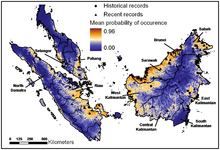Flat-headed cat
The flat-headed cat (Prionailurus planiceps) is a wildcat that lives in Indonesia and Malaysia. It used to live in Thailand but may be extinct there.[1][2]
| Flat-headed cat | |
|---|---|

| |
| Scientific classification | |
| Domain: | Eukaryota |
| Kingdom: | Animalia |
| Phylum: | Chordata |
| Class: | Mammalia |
| Order: | Carnivora |
| Suborder: | Feliformia |
| Family: | Felidae |
| Subfamily: | Felinae |
| Genus: | Prionailurus |
| Species: | P. planiceps
|
| Binomial name | |
| Prionailurus planiceps | |

| |
This cat is 45 to 52 cm long (18 to 20 inches) and its tail is another 12 to 17 cm long (4.7 to 7 inches). It weights 1.5 to 2.5 kilograms (3.3 to 5.5 pounds). It is about the size of a domestic cat but its legs and tail are shorter, its body is longer, its paws are rounder, and its head is flatter. Its fur is red-brown and dark brown and it has white marks on its face and a white belly. Unlike most cats' claws, the flat-headed cat's claws do not retract all the way.[2]
The flat-headed cat lives in low rainforests, swamps, lakes, and forests with rivers in them. It catches its food in the water, and its body helps: Its teeth point backwards in its mouth so fish cannot get away. Its jaws are longer and narrower than other cats' jaws. It has some webbing between its toes.[2]
Some scientists think this cat likes water even more than the fishing cat does. When some scientists studying apes caught a flat-headed cat by accident, they let it go between a forest and a river. The cat ran to the river and dove in instead of running to the trees to hide. The scientists thought that the cat felt safer in the water than in the trees.[2]
Like other cats, the flat-headed cat sprays urine to mark its territory, but while other cats stand up and spray onto a tall object like a tree. The flat-headed cat crouches down and sprays while it walks, leaving its urine on the ground.[2]
The flat-headed cat is pregnant for 56 days. Female cats have one to four kittens at a time. In zoos, a flat-headed cat can live 14 years.[2]
Flat-headed cats are endangered because of pollution and because humans catch too many fish but mostly because humans have cut down the forests to build farms. Flat-headed cats like forests that are not too far above sea level, and this makes good farmland, so humans want it. Some scientists think that flat-headed cats can live in forests that have grown back after being cut down. Scientists do not think the flat-headed cat can hunt and live near farms[2] the way the Iriomote cat does.[3]

References
change- ↑ 1.0 1.1 Wilting, A.; Brodie, J.; Cheyne, S.; Hearn, A.; Lynam, A.; Mathai, J.; McCarthy, J.; Meijaard, E.; Mohamed, A.; Ross, J.; Sunarto, S.; Traeholt, C. (2015). "Prionailurus planiceps". 2015. The IUCN Red List of Threatened Species: e.T18148A50662095. doi:10.2305/IUCN.UK.2015-2.RLTS.T18148A50662095.en.
{{cite journal}}: Cite journal requires|journal=(help) - ↑ 2.0 2.1 2.2 2.3 2.4 2.5 2.6 "Flat-headed Cat". International Society for Endangered Cats Canada. Retrieved July 14, 2020.
- ↑ Rachel Nuwer (January 8, 2019). "The Risky Fame of a Rare Island Wildcat". Hakai Magazine. Retrieved July 5, 2020.
